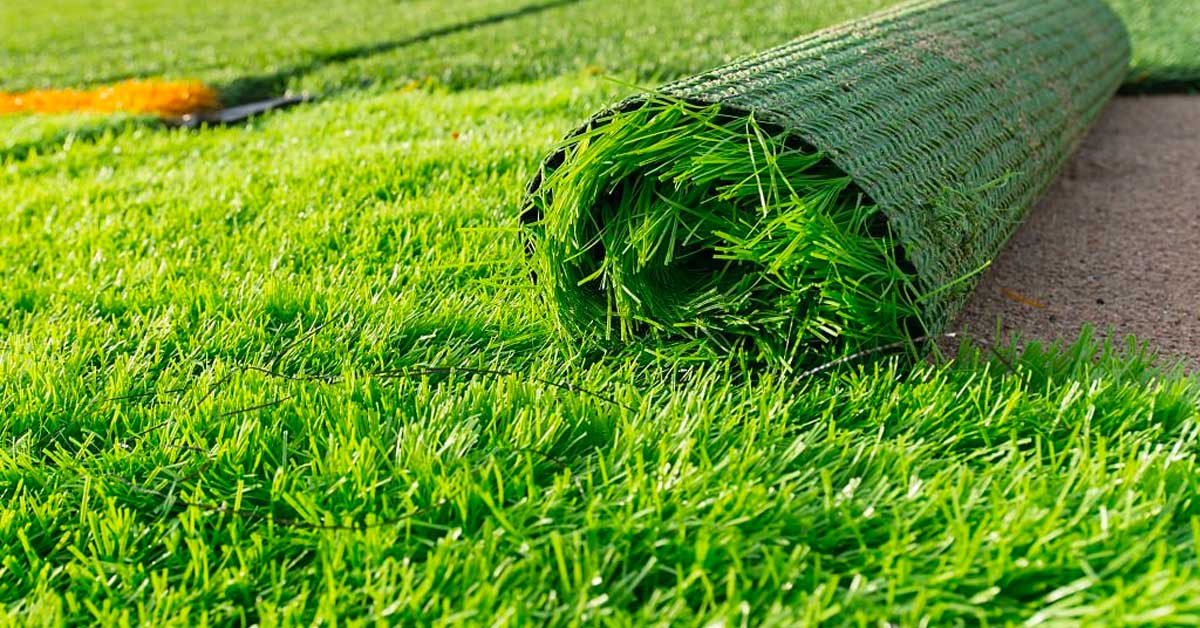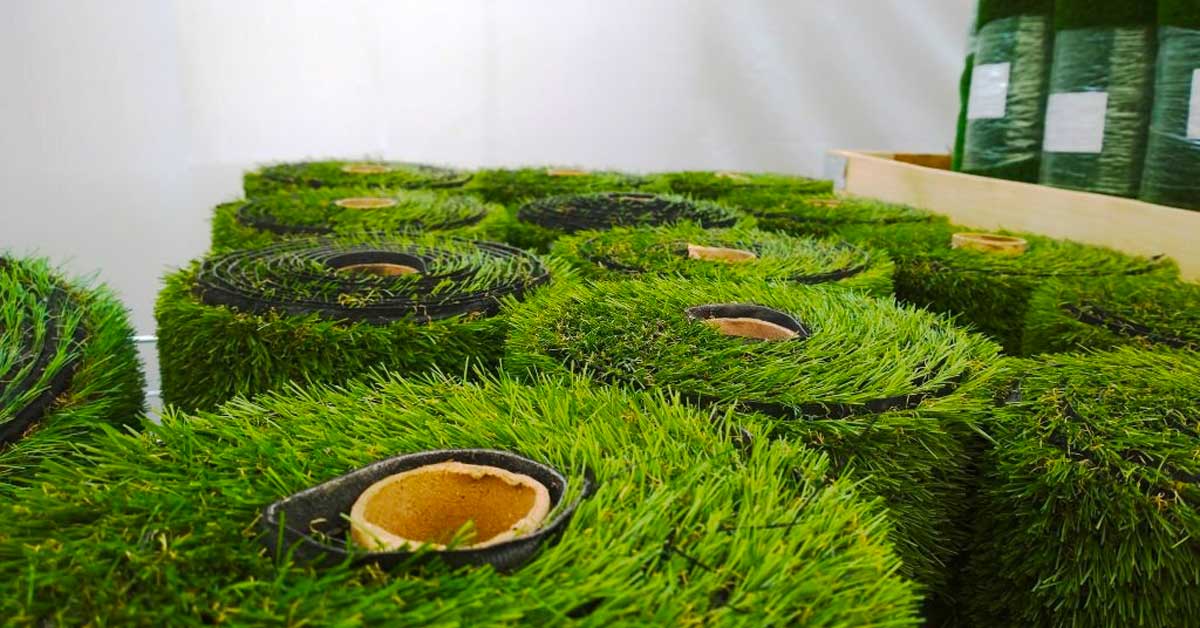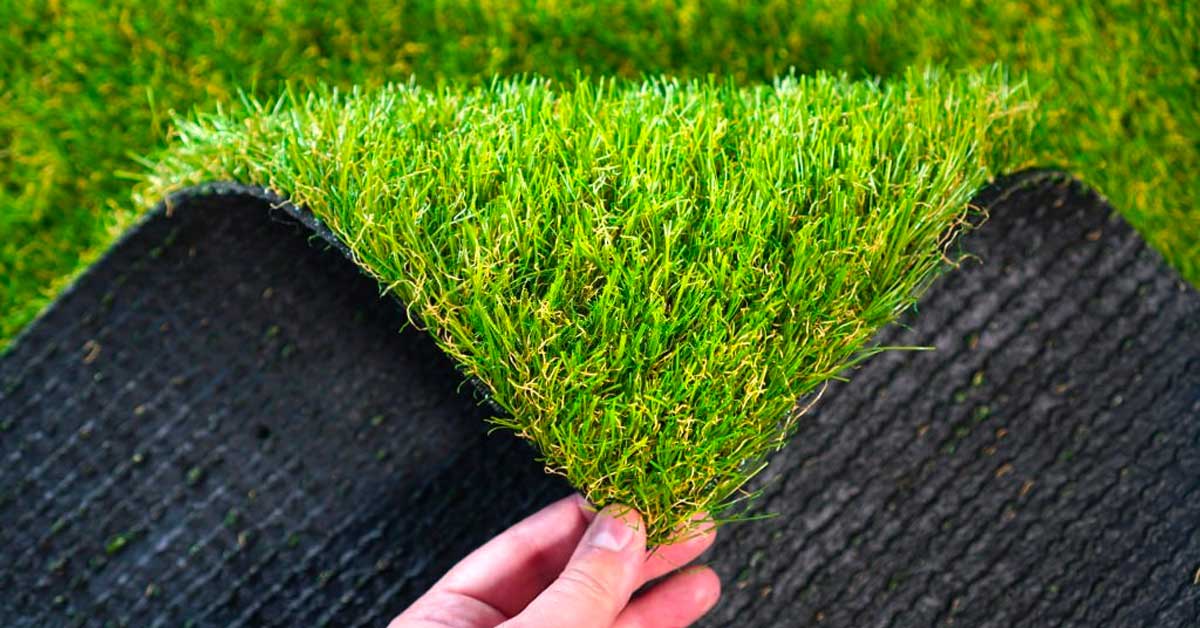Artificial grass, also known as synthetic turf, is commonly used in stadiums and sports fields around the world. It provides a consistent and durable playing surface that can withstand heavy use and adverse weather conditions. Here are some key points about artificial grass for stadiums:
Performance and Playability: Modern artificial grass systems are designed to mimic the look and feel of natural grass while offering improved durability and playability. The surface is engineered to provide consistent ball bounce and roll, making it suitable for various sports like football, soccer, rugby, and field hockey.
Durability: Synthetic turf is designed to withstand heavy usage and maintain its quality over time. It can handle intense foot traffic, withstand cleat marks, and resist tearing and divoting. This durability makes it an excellent choice for stadiums that host frequent sporting events and concerts.
All-Weather Capability: One of the significant advantages of artificial grass is its ability to withstand adverse weather conditions. It can drain water quickly, allowing games to continue even after heavy rainfall. Additionally, it doesn’t become muddy, reducing the risk of injuries and maintaining consistent playability.
Low Maintenance: Artificial grass requires significantly less maintenance compared to natural grass. It doesn’t need mowing, watering, or fertilizing, saving both time and resources. Regular brushing and occasional cleaning to remove debris and ensure evenness are typically sufficient for maintenance.
Customizability: Synthetic turf can be customized to meet the specific requirements of stadiums. It can be installed with different pile heights, infill materials, and drainage systems, allowing for tailored performance characteristics. It also provides opportunities for branding with customized logos and colors.
Safety Considerations: Player safety is a crucial factor in stadium design. Artificial grass systems are designed to reduce the risk of injuries by providing consistent and forgiving playing surfaces. They can be engineered with shock-absorbing properties and cushioning underlayers to minimize the impact on players.
Environmental Considerations: While artificial grass does not require water and reduces the need for chemical fertilizers and pesticides, it is important to consider the environmental impact of the materials used. Some artificial turf systems are now being designed with eco-friendly and recyclable components to address these concerns.
When selecting artificial grass for stadiums, it’s essential to work with experienced suppliers and manufacturers who can provide high-quality products and ensure proper installation. Compliance with sports governing bodies’ regulations, such as FIFA or World Rugby, may also be necessary, depending on the sports played in the stadium.
Do Stadiums Use Artificial Grass?
Yes, stadiums do use artificial grass, also known as synthetic turf. Artificial grass has gained popularity in stadiums and sports fields worldwide due to its durability, all-weather capability, and low maintenance requirements. Many stadiums have opted for artificial turf over natural grass because it offers several advantages for both the stadium management and the athletes who use the facilities.
Artificial grass provides a consistent playing surface that can withstand heavy usage, making it suitable for hosting multiple sporting events and concerts without significant wear and tear. It is commonly used in stadiums for various sports such as football, soccer, rugby, American football, field hockey, and more. Stadiums with retractable roofs or indoor arenas often choose artificial turf to maintain a uniform playing surface regardless of weather conditions.
Furthermore, artificial grass has advanced significantly over the years, with manufacturers developing high-quality systems that closely mimic the look and feel of natural grass. The technology behind synthetic turf has evolved to provide improved playability, shock absorption, and ball bounce characteristics, enhancing the overall performance for athletes.
In summary, the use of artificial grass in stadiums is widespread and continues to grow due to its numerous advantages in terms of durability, playability, maintenance, and all-weather capabilities.
How Much is Artificial Grass For a Football Stadium?
The cost of installing artificial grass in a football stadium can vary widely depending on various factors such as the size of the stadium, the specific requirements of the project, the quality of the synthetic turf system, and additional features like drainage systems or shock-absorbing underlayers.
It is challenging to provide an exact figure without specific details, but generally, the cost of artificial grass installation for a football stadium can range from several hundred thousand dollars to several million dollars.
Some of the factors that can influence the cost include:
- Size of the Stadium: The larger the stadium, the more square footage of artificial grass will be required, leading to higher costs.
- Quality of Synthetic Turf: Different synthetic turf systems have varying qualities, performance characteristics, and price points. Higher-quality turf systems that offer advanced features and durability may come at a higher cost.
- Site Preparation: If the stadium requires significant site preparation work, such as leveling the ground or improving drainage, the overall cost will increase.
- Additional Features: Certain stadiums may require specialized features like shock-absorbing underlayers, infill materials, or specific branding elements. These additional features can add to the overall cost.
- Installation and Labor: The cost of labor and installation services will depend on the complexity of the project, accessibility of the stadium, and the experience of the installation team.
It’s important to note that the cost of artificial grass installation for a football stadium is a significant investment and should be evaluated on a case-by-case basis. It’s advisable to consult with experienced synthetic turf suppliers and installation professionals who can assess the specific requirements of the stadium and provide accurate cost estimates.

What Artificial Grass do They Use For Football Fields?
There are various types of artificial grass systems used for football fields, and the choice depends on factors such as performance requirements, budget, and the specific needs of the stadium. Here are three commonly used types of artificial grass for football fields:
- Monofilament Grass: Monofilament grass consists of individual synthetic fibers that are typically cylindrical or slightly flattened in shape. This type of artificial grass provides excellent durability and resilience, making it suitable for high-traffic football fields. The fibers are designed to resist wear and maintain their shape, ensuring consistent playability.
- Slit-Film Grass: Slit-film grass is made up of multiple thin and flat fibers that are slit lengthwise. This type of artificial grass is known for its exceptional durability and resistance to splitting. It offers good traction and ball roll characteristics, making it suitable for football fields that experience intense use.
- Hybrid Grass: Hybrid grass systems combine natural grass with artificial turf. The field consists of natural grass reinforced with synthetic fibers that are woven into the ground. This combination offers the benefits of both natural and artificial grass, providing improved durability, stability, and enhanced playing conditions. Hybrid grass systems are often used in stadiums that host professional football matches.
It’s important to note that within each type of artificial grass, there can be a wide range of variations in terms of pile height, fiber composition, infill materials, and other performance characteristics. The choice of artificial grass for a football field depends on factors such as climate, maintenance requirements, player safety, and the regulations of sports governing bodies.
When selecting artificial grass for a football field, it is recommended to consult with experienced suppliers, turf manufacturers, and sports field experts who can provide guidance and help determine the most suitable option for the specific requirements of the stadium.
Do Soccer Stadiums use Artificial Grass?
Yes, soccer stadiums do use artificial grass, also known as synthetic turf. The use of artificial grass in soccer stadiums has become increasingly common due to its numerous advantages over natural grass. Here are some reasons why soccer stadiums opt for artificial turf:
- Durability: Synthetic turf is highly durable and can withstand heavy usage, making it suitable for soccer stadiums that host frequent matches, practices, and events. It can handle intense foot traffic, resist tearing and divoting, and maintain its quality over time.
- All-Weather Capability: Artificial grass offers excellent all-weather performance, allowing soccer matches to take place even after heavy rain. The surface drains water quickly, preventing the field from becoming muddy and ensuring consistent playability in various weather conditions.
- Consistency: Synthetic turf provides a consistent playing surface with even ball bounce and roll. This consistency allows players to develop and maintain their skills, leading to fair competition and enhanced performance.
- Low Maintenance: Artificial grass requires less maintenance compared to natural grass. It eliminates the need for mowing, watering, and fertilizing, saving time and resources. Regular brushing and occasional cleaning to remove debris are typically sufficient for maintenance.
- Player Safety: Player safety is a crucial consideration in soccer stadiums. Artificial grass can be designed with shock-absorbing properties and cushioning underlayers to minimize the risk of injuries. It offers a stable and predictable surface, reducing the chances of slips, divots, or uneven patches.
- Multi-Purpose Use: Many soccer stadiums host other events such as concerts, exhibitions, and community gatherings. Artificial grass allows for versatile use as it can withstand various activities without significant damage, providing a consistent playing surface for both soccer and other events.
While some soccer stadiums still use natural grass, the adoption of artificial grass has increased due to its advantages in terms of durability, playability, all-weather performance, and lower maintenance requirements. The choice between natural grass and artificial turf often depends on factors such as climate, budget, stadium usage, and personal preferences.
What is a Hybrid Grass Field?
A hybrid grass field, also known as a hybrid turf system or reinforced natural grass, is a type of playing surface that combines natural grass with synthetic fibers. It is a hybrid solution that aims to combine the benefits of both natural grass and artificial turf.
In a hybrid grass field, the natural grass is reinforced and supported by synthetic fibers that are woven into the ground or inserted vertically into the turf. These synthetic fibers are typically made of materials such as polyethylene or polypropylene. The fibers are evenly distributed throughout the playing surface to provide stability, resilience, and durability.
The synthetic fibers serve several purposes in a hybrid grass field:
- Stability: The synthetic fibers help stabilize the natural grass roots and provide reinforcement to prevent excessive wear and tear. This stability allows the grass to recover quickly after intense usage and reduces the risk of divots or bare patches.
- Durability: The synthetic fibers enhance the durability of the natural grass, making it more resistant to damage caused by foot traffic, sliding tackles, and adverse weather conditions. This helps maintain a consistent playing surface throughout the season.
- Increased Playing Hours: A hybrid grass field can withstand more playing hours compared to natural grass alone. It has the ability to recover quickly after matches or training sessions, allowing for more frequent use without compromising the quality of the playing surface.
- Improved Drainage: The synthetic fibers help improve the drainage capabilities of the field, allowing water to flow through the surface more efficiently. This helps prevent waterlogging and ensures better playing conditions even during rainy periods.
Hybrid grass fields are commonly used in professional sports stadiums, including soccer and rugby fields. They offer the aesthetic and natural feel of grass while providing the durability and resilience of synthetic turf. However, it’s worth noting that hybrid grass fields require specialized maintenance and care to ensure the longevity and performance of both the natural grass and synthetic fibers.

What is a Hybrid Football Stadium?
The term “hybrid football stadium” does not refer to a specific type of stadium but rather a concept that combines various elements or features from different stadium designs or technologies. A hybrid football stadium typically incorporates a mix of traditional and modern elements to enhance the overall fan experience, functionality, and versatility of the venue. Here are a few examples of what a hybrid football stadium might entail:
Architectural Design
A hybrid football stadium may feature a combination of traditional architectural elements, such as classic stadium design and seating arrangements, with modern design elements, such as contemporary facades, advanced lighting systems, or innovative roof structures.
Multi-Purpose Usage
A hybrid football stadium is designed to accommodate multiple events and activities beyond football matches. It may include facilities for concerts, conferences, exhibitions, or other sporting events, allowing the venue to be utilized throughout the year and generating revenue from various sources.
Technological Integration
Hybrid stadiums often incorporate advanced technological features to enhance the spectator experience. This may include state-of-the-art video screens, interactive displays, wireless connectivity, or augmented reality/virtual reality experiences for fans.
Sustainability and Green Initiatives
Hybrid football stadiums may prioritize sustainable design and incorporate eco-friendly features. This could involve using renewable energy sources, implementing efficient waste management systems, incorporating green spaces, or utilizing environmentally friendly construction materials.
Fan Amenities and Hospitality
Hybrid stadiums focus on providing exceptional fan amenities and hospitality options. This might include premium seating areas, VIP lounges, restaurants, bars, retail spaces, and enhanced concessions, catering to different fan preferences and creating a memorable experience.
It’s important to note that the term “hybrid football stadium” is not universally defined, and the specific characteristics and features may vary from one stadium to another. The concept of a hybrid stadium generally revolves around integrating traditional and modern elements to create a versatile and fan-friendly venue that goes beyond the core functionality of hosting football matches.
What is Hybrid Grass For Football?
Hybrid grass for football, also known as hybrid turf or reinforced natural grass, is a specialized playing surface that combines natural grass with synthetic fibers to enhance its durability and stability. It is specifically designed to withstand the intense use and demanding conditions of football matches while maintaining the natural feel and appearance of grass. Here are some key characteristics of hybrid grass for football:
- Natural Grass Base: Hybrid grass starts with a base layer of natural grass. This natural grass is typically a high-quality, dense, and hard-wearing variety that is suitable for sports fields.
- Synthetic Fibers: Synthetic fibers, usually made of materials like polyethylene or polypropylene, are integrated into the natural grass. These fibers are evenly distributed throughout the field, inserted vertically into the turf, or woven into the ground to provide reinforcement and stability.
- Root Growth and Fiber Integration: The synthetic fibers help anchor the natural grass roots and create a stable surface. The integration of fibers also promotes better root growth, which results in a stronger and more resilient turf.
- Increased Durability: The combination of natural grass and synthetic fibers enhances the durability of the playing surface. It can withstand heavy use, recover faster from wear and tear, and resist divoting, resulting in a more consistent playing surface throughout the football season.
- Improved Stability: The synthetic fibers add stability to the turf, preventing excessive movement, shifting, or unevenness during matches. This stability is especially important for player safety and performance, as it reduces the risk of injuries and ensures a predictable playing surface.
- Enhanced Drainage: Hybrid grass systems typically have improved drainage capabilities compared to natural grass alone. The synthetic fibers help facilitate water flow and prevent waterlogging, allowing the field to be playable even in wet conditions.
- Maintenance Requirements: Hybrid grass fields require specialized maintenance to ensure the longevity and performance of both the natural grass and synthetic fibers. Regular mowing, irrigation, and grooming are necessary to keep the natural grass healthy, while occasional brushing and fiber manipulation help maintain the stability and integration of the synthetic fibers.
Hybrid grass for football provides a balance between the natural characteristics of grass and the added durability and stability of synthetic fibers. It is commonly used in professional football stadiums to ensure optimal playing conditions and extend the usability of the field despite intense usage.

